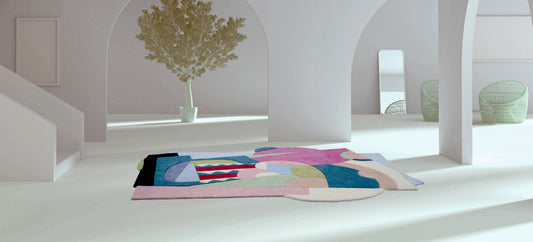Abstract Art
Abstraction found its seat at the table of modern art by the early 1900s. But what is Abstract art?
Abstraction is a term that can be used to describe art that rejects realistic representation in favour of schematized or over-simplified forms, focusing on colour, lines, composition and shapes to invoke emotion. The philosophy behind abstract art includes the 'art for art’s sake' argument, and also draws on the similarity between art and music. Similar to how music is composed from patterns of sound, art too should be a composition of pure patterns of colour and form.
There is an overall consensus when pinning down a date of the origins of abstract art, the year 1910. This was the year when Wassily Kandinsky created what is believed to be the first abstract watercolour. Kandinsky himself believed this, in one of his letters he wrote:
“Indeed, it’s the world’s first ever abstract picture, because back then not one single painter was painting in an abstract style. A ‘historic painting’, in other words.”
Wassily Kandinsky
The most famous among his early works is The Blue Rider (Der Blaue Reiter) 1903

Kandinsky was a Russian painter and art theorist, who contributed to the avant-garde movement and was an instructor at the Bauhaus school of art. His rejection of formal composition in his works is what conferred upon abstraction, its definition and major attributes.
"Music is the ultimate teacher."
-Wassily Kandinsky
Kandinsky's art style commences with Realism and gradually evolved over the span of 46 years into Abstraction. His early art was influenced by Pointillism, Fauvism, Impressionists like Claude Monet, philosophers and even music composers. Undeniably, Kandinsky's gift of Synesthesia, the ability to hear sound in colour, had a considerable influence on his approach and creation of art. He used musical terms such as improvisations, impressions or compositions as titles for his works. Instrumental sounds were represented with colours, for instance, bright yellow symbolised the tone of a trumpet.
Kandinsky's Approach to Abstraction
Not only his works but also his artistic theories and creativity brought him great renown. He had been contemplating abstract art for years, he even published a manifesto On the Spiritual in Art regarding Abstraction. Kandinsky believed that extracting material recognizable forms from a painting will leave you with a piece of art that references nothing but itself. To him, the artist played the role of a prophet and art was his spiritual vehicle. He was successful in deriving a pictorial language of colour and form barely tied to the material world, instead speaking volumes about the artist's "inner necessity," ie. their perception and emotion.
“Objects damage pictures.”
-Wassily Kandinsky
His choice of materials varied considerably, he used canvas, wood, plywood, glass, compressed board, etc. He was consistently inclined towards bold colours in oil, watercolour, gouache, tempera and even mixtures. The Great Synthesis (1934–1944) corresponds to a period of Kandinsky’s life when his art reached its actualization. He incorporated all his previously used elements and styles into these works and enriched them significantly. Composition X was his final major composition.

Kandinsky’s oeuvre of Abstract art depicts a visual vocabulary of great depth and his knowledge of colour symbolism. It is expressive art personified that has transcended cultural and physical boundaries to refine the perception of art over generations.
It may be unfair to credit Kandinsky as the singular father of Abstract Art, since he was by no means the only pioneer of non-representational painting. However his works were revolutionary enough to compel the public’s attention and lay the very foundations of Abstract art as we know it today. His influence continues to permeate modern art today. Ruggism is proud to present its Kandinsky collection, composed of designs primarily inspired by Kandinsky’s great works. Check out the collection here.
Bonus Fact:
 It is believed that Kandinsky found his passion for abstraction when he happened upon an unrecognisable painting in his studio during twilight. The realisation then dawned upon him that it was his own painting, only upside down, this was accompanied with the realisation of the potential of Abstraction.
It is believed that Kandinsky found his passion for abstraction when he happened upon an unrecognisable painting in his studio during twilight. The realisation then dawned upon him that it was his own painting, only upside down, this was accompanied with the realisation of the potential of Abstraction.







